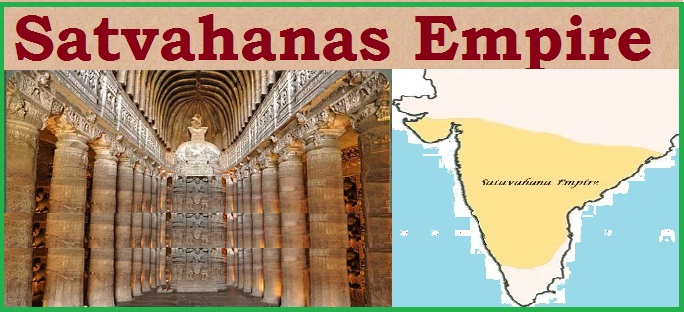The Satavahanas-Post-Mauryan India-NCERT Notes For W.B.C.S Examination.
সাতবাহন – পোস্ট – মৌরিয়ান ভারত – WBCS পরীক্ষার জন্য এনসিইআরটির নোটস।
The Sunga dynasty came to an end in around 73 BC when their ruler Devabhuti was killed by Vasudeva Kanva. The Kanva dynasty then ruled over Magadha for about 45 years. Around this time, another powerful dynasty, the Satavahanas came to power in the Deccan area.Continue Reading The Satavahanas-Post-Mauryan India-NCERT Notes For W.B.C.S Examination.
- As per the puranas, there were four kings of the Kanva dynasty namely, Vasudeva, Bhumimitra, Narayana and Susarman.
- The Kanvas were Brahmins.
- The Magadha Empire had diminished by this time considerably.
- Northwest region was under the Greeks and parts of the Gangetic plains were under different rulers.
- The last Kanva king Susarman was killed by the Satavahana (Andhra) king.
- The Cheti or Chedi dynasty emerged in Kalinga in the 1st century BC.
- The Hathigumpha inscription situated near Bhubaneswar gives information about it.
- This inscription was engraved by king Kharavela who was the third Cheti king.
- Kharavela was a follower of Jainism.
- Other names of this dynasty are Cheta or Chetavamsa, and Mahameghavahana.
- The Satavahana rule is believed to have started around the third century BC, in 235 BC and lasted until the second century AD.
- Some experts believe their rule started in the first century BC only.
- They are referred to as Andhras in the Puranas.
- The Satavahana kingdom chiefly comprised of modern-day Andhra Pradesh, Telangana and Maharashtra. At times, their rule also included parts of Karnataka, Gujarat and Madhya Pradesh.
- Their capital cities varied at different times. Pratishthana (Paithan) and Amaravati were its capitals.
- Simuka founded the dynasty.
- They were the first native Indian rulers to issue their own coins with the portraits of the rulers. This practice was started by Gautamiputra Satakarni who derived the practice from the Western Satraps after defeating them.
- The coin legends were in Prakrit language. Some reverse coin legends are in Telugu, Tamil and Kannada.
- They patronised Prakrit more than Sanskrit.
- They supported both Buddhism and Brahminism although they were Hindus and claimed Brahminical status.
- They successfully defended their territories against foreign invaders and had many on-going battles with the Sakas (Western Satraps).
- Sarakarni I was the third Satavahana king.
- Satakarni I was the first Satavahana king to expand his empire by military conquests.
- He conquered Kalinga after the death of Kharavela.
- He also pushed back the Sungas in Pataliputra.
- He also ruled over Madhya Pradesh.
- After annexing the Godaveri Valley, he assumed the title of ‘Lord of Dakshinapatha’.
- His queen was Nayanika who wrote the Naneghat inscription which describes the king as Dakshinapathapati.
- He performed Ashvamedha and revived Vedic Brahminism in the Deccan.
- King Hala compiled the Gatha Saptashati. Called Gaha Sattasai in Prakrit, it is a collection of poems with mostly love as the theme. Around forty of the poems are attributed to Hala himself.
- Hala’s minister Gunadhya composed Brihatkatha.
- He is considered the greatest king of the Satavahana dynasty.
- He defeated the Greeks, Pahlavas (Indo-Parthians) and the Sakas.
- His kingdom ran from Krishna in the south to Malwa and Saurashtra in the north and from Berar in the east to the Konkan in the west.
- He defeated Nahapana, an important king of the Western Satraps.
- He is also called Ekabrahmana.
- His mother was Gautami Balasri and hence his name Gautamiputra (son of Gautami).
- He was succeeded by his son Vasisthiputra Sri Pulamavi or Pulamavi II.
- Pulamavi IV is considered the last king of the main Satavahana line.
- He ruled until 225 AD. After his death, the empire fragmented into five smaller kingdoms.
Our own publications are available at our webstore (click here).
For Guidance of WBCS (Exe.) Etc. Preliminary , Main Exam and Interview, Study Mat, Mock Test, Guided by WBCS Gr A Officers , Online and Classroom, Call 9674493673, or mail us at – mailus@wbcsmadeeasy.in
Visit our you tube channel WBCSMadeEasy™ You tube Channel
Please subscribe here to get all future updates on this post/page/category/website



 Toll Free 1800 572 9282
Toll Free 1800 572 9282  mailus@wbcsmadeeasy.in
mailus@wbcsmadeeasy.in


















































































































